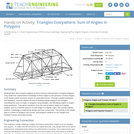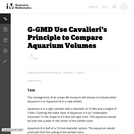
Students learn about regular polygons and the common characteristics of regular polygons. They relate their mathematical knowledge of these shapes to the presence of these shapes in the human-made structures around us, especially trusses. Through a guided worksheet and teamwork, students explore the idea of dividing regular polygons into triangles, calculating the sums of angles in polygons using triangles, and identifying angles in shapes using protractors. They derive equations 1) for the sum of interior angles in a regular polygon, and 2) to find the measure of each angle in a regular n-gon. This activity extends students’ knowledge to engineering design and truss construction. This activity is the middle step in a series on polygons and trusses, and prepares students for the Polygon and Popsicle Trusses associated activity.
- Subject:
- Geometry
- Mathematics
- Material Type:
- Activity/Lab
- Provider:
- TeachEngineering
- Author:
- Andi Vicksman
- Maia Vadeen
- Malinda Zarske
- Nathan Coyle
- Russell Anderson
- Ryan Sullivan
- Sabina Schill
- Date Added:
- 02/07/2017

